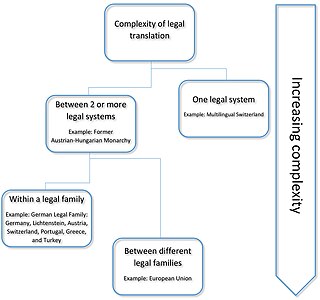The following outline is provided as an overview and topical guide to linguistics:
Lexicography is the study of lexicons, and is divided into two separate academic disciplines. It is the art of compiling dictionaries.
Corpus linguistics is the study of a language as that language is expressed in its text corpus, its body of "real world" text. Corpus linguistics proposes that a reliable analysis of a language is more feasible with corpora collected in the field—the natural context ("realia") of that language—with minimal experimental interference.
Linguistics is the scientific study of human language. Someone who engages in this study is called a linguist. See also the Outline of linguistics, the List of phonetics topics, the List of linguists, and the List of cognitive science topics. Articles related to linguistics include:
Terminology is a group of specialized words and respective meanings in a particular field, and also the study of such terms and their use; the latter meaning is also known as terminology science. A term is a word, compound word, or multi-word expressions that in specific contexts is given specific meanings—these may deviate from the meanings the same words have in other contexts and in everyday language. Terminology is a discipline that studies, among other things, the development of such terms and their interrelationships within a specialized domain. Terminology differs from lexicography, as it involves the study of concepts, conceptual systems and their labels (terms), whereas lexicography studies words and their meanings.

Legal translation is the translation of language used in legal settings and for legal purposes. Legal translation may also imply that it is a specific type of translation only used in law, which is not always the case. As law is a culture-dependent subject field, legal translation is not necessarily linguistically transparent. Intransparency in translation can be avoided somewhat by use of Latin legal terminology, where possible, but in non-western languages debates are centered on the origins and precedents of specific terms, such as in the use of particular Chinese characters in Japanese legal discussions.
Specialized lexicography is an academic discipline that is concerned with development of theories and principles for the design, compilation, use and evaluation of specialized dictionaries. A specialized dictionary is a dictionary that covers a relatively restricted set of phenomena, usually within one or more subject fields. An alternative term for this type of dictionary is LSP dictionary.
Translation studies is an academic interdiscipline dealing with the systematic study of the theory, description and application of translation, interpreting, and localization. As an interdiscipline, translation studies borrows much from the various fields of study that support translation. These include comparative literature, computer science, history, linguistics, philology, philosophy, semiotics, and terminology.
Contrastive analysis is the systematic study of a pair of languages with a view to identifying their structural differences and similarities. Historically it has been used to establish language genealogies.
Beryl T. "Sue" Atkins was a British lexicographer, specialising in computational lexicography, who pioneered the creation of bilingual dictionaries from corpus data.
Linguistic categories include
Reinhard Rudolf Karl Hartmann is an Austrian and English lexicographer and applied linguist. Until the 1970s, lexicographers worked in relative isolation, and Hartmann is credited with making a major contribution to lexicography and fostering interdisciplinary consultation between reference specialists.
Linguistics is the scientific study of language. The modern-day scientific study of linguistics takes all aspects of language into account — i.e., the cognitive, the social, the cultural, the psychological, the environmental, the biological, the literary, the grammatical, the paleographical, and the structural.
Menella Bute Smedley (1820–1877) was a novelist and poet. A relative of Lewis Carroll, she wrote some minor novels and books of poems, including the anonymous, The Story of Queen Isabel, and Other Verses, 1863.
Irmengard Rauch is a linguist and semiotician.
Machine translation (MT) algorithms may be classified by their operating principle. MT may be based on a set of linguistic rules, or on large bodies (corpora) of already existing parallel texts. Rule-based methodologies may consist in a direct word-by-word translation, or operate via a more abstract representation of meaning: a representation either specific to the language pair, or a language-independent interlingua. Corpora-based methodologies rely on machine learning and may follow specific examples taken from the parallel texts, or may calculate statistical probabilities to select a preferred option out of all possible translations.

Ranko Bugarski is a Serbian linguist, academic and author.

Sketch Engine is a corpus manager and text analysis software developed by Lexical Computing CZ s.r.o. since 2003. Its purpose is to enable people studying language behaviour to search large text collections according to complex and linguistically motivated queries. Sketch Engine gained its name after one of the key features, word sketches: one-page, automatic, corpus-derived summaries of a word's grammatical and collocational behaviour. Currently, it supports and provides corpora in 90+ languages.

Dafydd Gibbon is a British emeritus professor of English and General Linguistics at Bielefeld University in Germany, specialising in computational linguistics, the lexicography of spoken languages, applied phonetics and phonology. He is particularly concerned with endangered languages and has received awards from the Ivory Coast, Nigeria and Poland.




